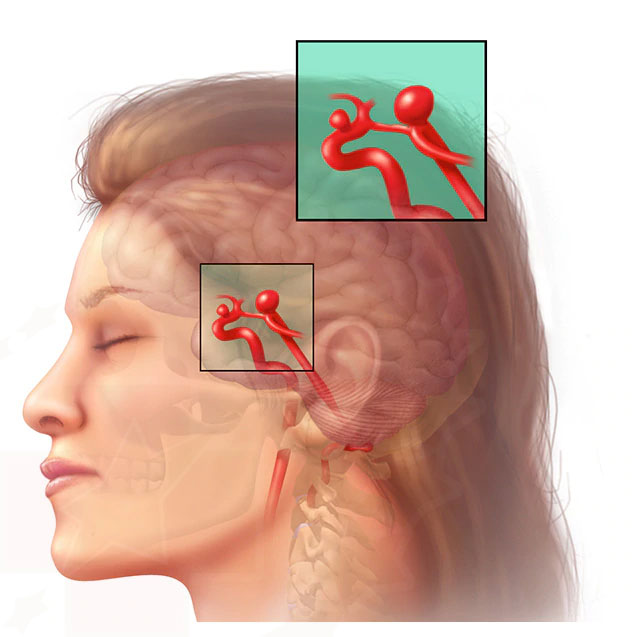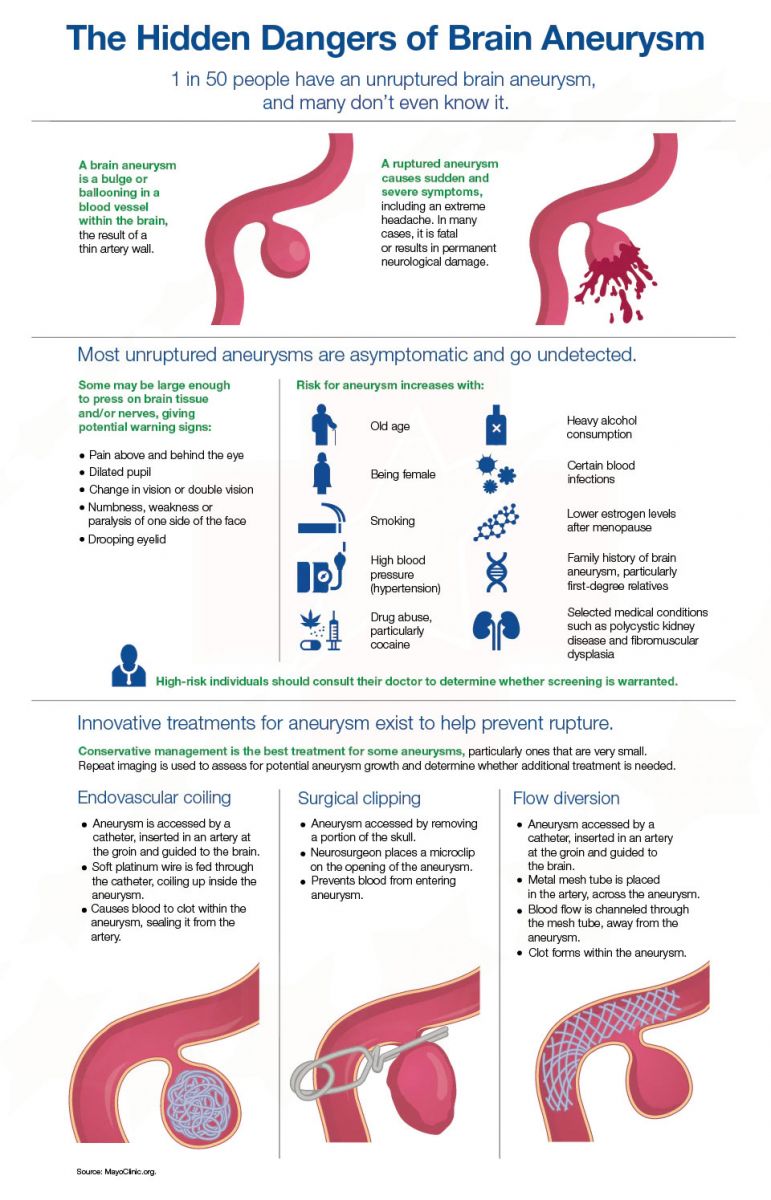Phình động mạch não (Brain Aneurysm)

Phình động mạch não

Nguyên nhân, triệu chứng và điêu trị phình động mạch não
1. Overview:
A brain aneurysm (AN-yoo-riz-um) is a bulge or ballooning in a blood vessel in the brain. It often looks like a berry hanging on a stem.
A brain aneurysm can leak or rupture, causing bleeding into the brain (hemorrhagic stroke). Most often a ruptured brain aneurysm occurs in the space between the brain and the thin tissues covering the brain. This type of hemorrhagic stroke is called a subarachnoid hemorrhage.
A ruptured aneurysm quickly becomes life-threatening and requires prompt medical treatment.
Most brain aneurysms, however, don't rupture, create health problems or cause symptoms. Such aneurysms are often detected during tests for other conditions.
Treatment for an unruptured brain aneurysm may be appropriate in some cases and may prevent a rupture in the future. Talk with your caregiver to ensure you understand the best options for your specific needs.
2. Symptoms:
- Ruptured aneurysm
A sudden, severe headache is the key symptom of a ruptured aneurysm. This headache is often described as the "worst headache" ever experienced.
Common signs and symptoms of a ruptured aneurysm include:
- Sudden, extremely severe headache
- Nausea and vomiting
- Stiff neck
- Blurred or double vision
- Sensitivity to light
- Seizure
- A drooping eyelid
- Loss of consciousness
- Confusion
- 'Leaking' aneurysm
In some cases, an aneurysm may leak a slight amount of blood. This leaking (sentinel bleed) may cause only a:
- Sudden, extremely severe headache
A more severe rupture often follows leaking.
- Unruptured aneurysm
An unruptured brain aneurysm may produce no symptoms, particularly if it's small. However, a larger unruptured aneurysm may press on brain tissues and nerves, possibly causing:
- Pain above and behind one eye
- A dilated pupil
- Change in vision or double vision
- Numbness of one side of the face
3. When to see a doctor:
Seek immediate medical attention if you develop a:
- Sudden, extremely severe headache
If you're with someone who complains of a sudden, severe headache or who loses consciousness or has a seizure, call 911 or your local emergency number.
Brain aneurysms develop as a result of thinning artery walls. Aneurysms often form at forks or branches in arteries because those sections of the vessel are weaker.
Although aneurysms can appear anywhere in the brain, they are most common in arteries at the base of the brain.
4. Causes:
The causes of brain aneurysm are unknown, but a range of factors may increase your risk.
5. Risk factors:
A number of factors can contribute to weakness in an artery wall and increase the risk of a brain aneurysm or aneurysm rupture. Brain aneurysms are more common in adults than in children and more common in women than in men.
Some of these risk factors develop over time; others are present at birth.
Risk factors that develop over time
These include:
- Older age
- Cigarette smoking
- High blood pressure (hypertension)
- Drug abuse, particularly the use of cocaine
- Heavy alcohol consumption
Some types of aneurysms may occur after a head injury (dissecting aneurysm) or from certain blood infections (mycotic aneurysm).
Risk factors present at birth
Selected conditions that date to birth can be associated with an elevated risk of developing a brain aneurysm. These include:
-
Inherited connective tissue disorders, such as Ehlers-Danlos syndrome, that weaken blood vessels
-
Polycystic kidney disease, an inherited disorder that results in fluid-filled sacs in the kidneys and usually increases blood pressure
-
Abnormally narrow aorta (coarctation of the aorta), the large blood vessel that delivers oxygen-rich blood from the heart to the body
-
Cerebral arteriovenous malformation (brain AVM), an abnormal connection between arteries and veins in the brain that interrupts the normal flow of blood between them
-
Family history of brain aneurysm, particularly a first-degree relative, such as a parent, brother, sister, or child
6. Complications:
When a brain aneurysm ruptures, the bleeding usually lasts only a few seconds. The blood can cause direct damage to surrounding cells, and the bleeding can damage or kill other cells. It also increases pressure inside the skull.
If the pressure becomes too elevated, the blood and oxygen supply to the brain may be disrupted to the point that loss of consciousness or even death may occur.
Complications that can develop after the rupture of an aneurysm include:
-
Re-bleeding. An aneurysm that has ruptured or leaked is at risk of bleeding again. Re-bleeding can cause further damage to brain cells.
-
Vasospasm. After a brain aneurysm ruptures, blood vessels in your brain may narrow erratically (vasospasm). This condition can limit blood flow to brain cells (ischemic stroke) and cause additional cell damage and loss.
-
Hydrocephalus. When an aneurysm rupture results in bleeding in the space between the brain and surrounding tissue (subarachnoid hemorrhage) — most often the case — the blood can block circulation of the fluid surrounding the brain and spinal cord (cerebrospinal fluid). This condition can result in an excess of cerebrospinal fluid that increases pressure on the brain and can damage tissues (hydrocephalus).
-
Hyponatremia. Subarachnoid hemorrhage from a ruptured brain aneurysm can disrupt the balance of sodium in the blood. This may occur from damage to the hypothalamus, an area near the base of the brain.
A drop in blood-sodium levels (hyponatremia) can lead to swelling of brain cells and permanent damage.
Địa chỉ: Số 6 Nguyễn Tri Phương, Hồng Bàng, Hải Phòng. Làm việc tất cả các ngày, kể cả ngày lễ tết. Liên tục từ 5 giờ sáng đến 9 giờ tối, không nghỉ trưa. Trực chụp cấp cứu 24 giờ. Điện thoại liên hệ: 0838737373 Email: 73dbp.goldstar@gmail.com
*Xem thêm các dịch vụ khác của chúng tôi:

